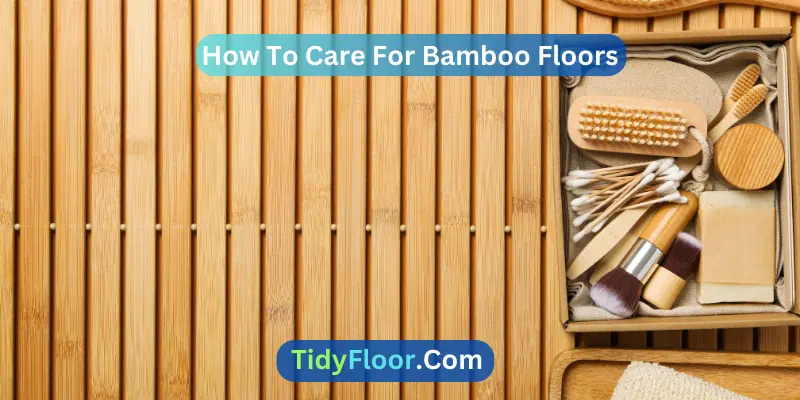Bamboo flooring has gained popularity in recent years due to its sustainability, durability, and unique aesthetic appeal. However, like any other type of flooring, bamboo floors require regular care and maintenance to ensure their longevity and beauty. If you’re a bamboo floor owner, it is important to take proper care of bamboo flooring.
Caring for bamboo floors involves regular dusting and sweeping, gentle cleaning with bamboo-friendly solutions, prompt spill cleanup, protective mats and rugs, avoiding high heels and sharp objects, and maintaining consistent indoor conditions for lasting beauty and durability.
In this guide, we’ll take you through a step-by-step process of how to care for bamboo floors to help you keep your bamboo floors looking pristine for years to come. Keep reading!
How To Care And Maintain Bamboo Flooring: 6 Step-By-Step Guide
It is a sensitive task to take care of bamboo floors as otherwise they can get damaged. This guide intends to inform the right technique and steps for bamboo flooring care so that you can achieve a sturdy and polished bamboo floor surface.
Step 1: Regular Dusting and Sweeping
The first and simplest step in maintaining your bamboo floors is regular dusting and sweeping. Use a soft-bristle broom or a microfiber mop to gently remove dust, dirt, and debris. This prevents particles from scratching the surface of the bamboo and helps maintain its natural shine.
Step 2: Gentle Cleaning Solutions
When your bamboo floors require deeper cleaning, avoid using harsh chemicals that can damage the finish. Instead, opt for a pH-neutral, bamboo-friendly floor cleaner. Mix the cleaner with water as directed and use a damp (not soaking wet) mop or cloth to clean the floors. Remember to dry the floors immediately with a dry cloth to prevent moisture from seeping into the bamboo.
Step 3: Wipe Up Spills Promptly
Bamboo is susceptible to water damage, so it’s crucial to wipe up spills promptly. Even though bamboo is relatively moisture-resistant, standing water can seep into the seams and cause warping or swelling. Be sure to blot spills with a clean, dry cloth and follow up with the gentle cleaning solution if necessary.
Step 4: Use Protective Mats and Rugs
For proper bamboo wood floor care, place protective mats at the entrances to your home and high-traffic areas to prevent dirt and grit from being tracked onto your bamboo floors. In areas prone to spills, like the kitchen or dining room, use rugs or mats to provide an extra layer of protection. Ensure that these mats have non-slip backings to prevent accidents.
Step 5: Avoid High Heels and Sharp Objects
To prevent scratches and dents, discourage walking with high heels, and avoid dragging heavy furniture or sharp objects across your bamboo floors. Consider using furniture pads or felt protectors under the legs of chairs, tables, and other furniture items to prevent direct contact with the floor.
Step 6: Maintain Consistent Indoor Conditions
Bamboo floors can react to changes in humidity and temperature, leading to expansion or contraction. To maintain stable conditions, keep your indoor environment within a recommended humidity range of 40-60% and a consistent temperature. Use a humidifier or dehumidifier as needed to achieve this balance.
9 Cleaning Tips About How to Care for Bamboo Hardwood Floors: Expert Tips
Bamboo hardwood floors offer a stunning and eco-friendly flooring option that can add warmth and elegance to any space. To ensure that your bamboo hardwood floors maintain their beauty and durability for years to come, it’s essential to follow proper cleaning guidance. Here are some expert tips to follow:
Gentle Cleaning: Dampen a mop or cloth with a mixture of water and a mild bamboo-specific cleaner.
- Protect from Scratches: Place mats at entrances and use felt pads under furniture to prevent scratches.
- Wipe Spills Immediately: Wipe up any spills promptly to prevent moisture damage.
- Use a Soft Vacuum Attachment: When vacuuming, use a soft brush attachment to avoid scratching the surface.
- Rotate Rugs and Furniture: Periodically move rugs and furniture to ensure even wear and sun exposure.
- Test Cleaners: Before using any new cleaning product, test it in an inconspicuous area to ensure it doesn’t damage the finish.
- Dry Mopping: Use a dry mop to pick up fine particles and dust to prevent them from scratching the surface.
- Avoid Steam Cleaning: Avoid using steam cleaners, as excessive moisture can damage bamboo flooring.
- Reapply Finish as Needed: Depending on traffic and wear, you might need to reapply a protective finish to keep the bamboo looking its best.
- Regular Inspections: Regularly inspect the floor for any issues or damages, addressing them promptly to prevent further problems.
10 Mistakes to Avoid When Caring for Engineered Bamboo Floors
Engineered bamboo floors offer the perfect blend of sustainability and durability, making them a popular choice for modern homes. Proper care is essential to maintain their beauty and extend their lifespan.
To ensure you’re taking the right steps, it’s equally important to avoid common mistakes that can inadvertently harm your engineered bamboo floors. Here’s a detailed guide on what to steer clear of when caring for your engineered bamboo flooring:
1. Excessive Moisture:
One of the most critical mistakes to avoid is exposing your engineered bamboo floors to excess moisture. Unlike solid hardwood, bamboo is susceptible to water damage. Avoid mopping with a soaking wet mop or leaving spills unattended. Excessive moisture can lead to warping, swelling, and irreversible damage.
2. Harsh Cleaning Products:
Using harsh chemicals or abrasive cleaners on your engineered bamboo floors can strip away the protective finish, leaving them vulnerable to scratches and discoloration. Stick to pH-neutral, bamboo-friendly cleaning solutions, and always follow the manufacturer’s recommendations for cleaning products.
3. Skipping Regular Cleaning:
Neglecting regular cleaning and maintenance can lead to a buildup of dirt and debris, which can scratch the surface of your engineered bamboo floors over time. Establish a cleaning routine that includes sweeping or vacuuming with a soft brush attachment and using a damp mop as needed.
4. Dragging Furniture:
Dragging heavy furniture across your engineered bamboo floors can leave unsightly scratches and dents. Always lift and move furniture items instead of dragging them. Consider placing felt pads or furniture glides under the legs to prevent direct contact with the flooring.
5. Ignoring High-Traffic Areas:
High-traffic areas, such as entryways and hallways, are more susceptible to wear and tear. Ignoring these areas can result in uneven wear patterns and a less appealing appearance. Use rugs and mats in these areas to protect the flooring and distribute foot traffic.
6. Neglecting UV Protection:
Direct sunlight exposure can cause engineered bamboo floors to fade over time. Use window treatments like curtains or blinds to block UV rays and prevent discoloration. If possible, rearrange furniture periodically to even out sunlight exposure.
7. Not Monitoring Humidity:
Fluctuations in humidity levels can cause engineered bamboo floors to expand or contract, leading to gaps or buckling. Invest in a humidity monitor and maintain indoor humidity within the recommended range to prevent these issues.
8. Overlooking Pet Care:
Pet nails can scratch the surface of engineered bamboo floors. Trim your pets’ nails regularly and use area rugs in areas where they frequently move or play to minimize the risk of scratches.
9. Using Steam Mops:
Avoid using steam mops on engineered bamboo floors. The high heat and moisture can damage the flooring and compromise the adhesive layers within engineered bamboo planks.
10. Incorrect Installation:
If you’re installing engineered bamboo floors yourself, ensure you follow the manufacturer’s installation guidelines meticulously. Incorrect installation can result in premature wear and void warranties.
FAQs:
Can I Use Any Cleaning Solution On Bamboo Floors?
While you should avoid harsh chemicals, you can use a pH-neutral, bamboo-specific floor cleaner mixed with water. This ensures effective cleaning without damaging the bamboo’s finish.
How Often Should I Dust And Sweep My Bamboo Floors?
Regular dusting and sweeping, ideally every few days, prevent dirt and debris from scratching the bamboo’s surface, maintaining its natural shine.
Can I Place Heavy Furniture Directly On Bamboo Floors?
To prevent dents and scratches, use furniture pads or felt protectors under furniture legs. This precaution helps distribute the weight evenly and safeguards your floors.
Are Bamboo Floors Water-Resistant?
While bamboo is relatively moisture-resistant, it’s important to wipe up spills promptly and avoid standing water, as excessive moisture can lead to warping or swelling.
Can I Use Rugs And Mats On Bamboo Floors?
Yes, rugs and mats can provide an extra layer of protection in high-traffic areas and places prone to spills. Opt for rugs with non-slip backings to prevent accidents.
How Do I Prevent Humidity-Related Issues With Bamboo Floors?
Maintain indoor humidity between 40-60% and consistent temperatures. Use humidifiers or dehumidifiers as needed to prevent the expansion or contraction of the bamboo.
Can I Use A Steam Mop On Bamboo Floors?
It’s best to avoid steam mops, as excessive moisture can damage bamboo. Stick to damp mopping with a gentle cleaning solution and promptly drying the floors.
How Do I Repair Minor Scratches On Bamboo Floors?
For minor scratches, use a bamboo floor touch-up pen or a similar product recommended by the manufacturer. Apply the product to the scratch and gently blend it in.
Are Bamboo Floors Eco-Friendly?
Yes, bamboo is considered an eco-friendly flooring option due to its rapid growth and sustainability. It’s a renewable resource that requires fewer resources compared to traditional hardwoods.
How Long Do Bamboo Floors Typically Last?
With proper care, bamboo floors can last anywhere from 20 to 25 years or more. Regular maintenance and attention to prevention techniques contribute to their longevity.
Conclusion
Learning how to care for bamboo floors is a straightforward process that involves regular cleaning, prevention of water damage, and being mindful of potential hazards. By following the steps outlined in this guide, you can ensure that your bamboo floors remain beautiful and resilient for many years.
With the right care, you can enjoy the warmth and elegance of bamboo in your home for generations to come.


